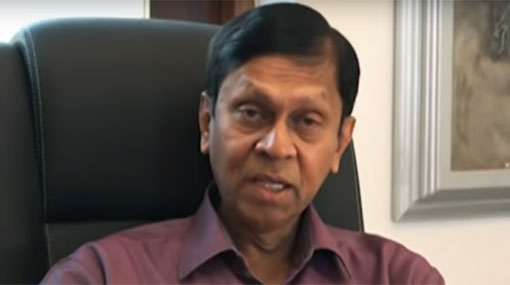Cabraal says New York Times article is ‘fake’ news
June 28, 2018 12:07 pm
Former Governor of the Central Bank of Sri Lanka, Ajith Nivard Cabraal, has refuted the allegations made in a recent article published by The New York Times, referring to it as ‘fake’ news which has violated the truth and a gross misrepresentation of facts.
The New York Times article dated 25 June 2018 titled “How China got Sri Lanka to cough up a Port,” written by Maria Abi-Habib, had made certain accusations pertaining to China’s acquisition of the strategic Hambantota port from Sri Lanka while highlighting Beijing’s “debt trap” and ambitious use of loans to gain influence around the world.
The report says feasibility studies had found that the port would not work and “frequent lenders” like India had refused to provide loans or assistance for the port, developed during Sri Lanka’s president Mahinda Rajapaksa’s rule.
However, issuing a response today, Rajapaksa’s former Central Bank chief Ajith Nivard Cabraal slammed the NYT article as a gross misrepresentation of facts as well as a piece of journalism which has violated the truth in a shocking manner.
“This is probably the type of propaganda under the veil of journalism that President Donald Trump has been regularly referring to as ‘Fake’ news or reports,” he charged.
The article had also pointed out certain facts pertaining to Sri Lanka debt position under the former President’s reign and also claimed that Rajapaksa’s campaign aides have received direct payments from the Chinese port construction fund.
Cabraal said that he was interviewed by the NYT correspondent in question Maria Abi- Habib on 10th May 2018, and that he countered “almost every one of her string of allegations and pre-conceived notions” in an hour long interview, with irrefutable facts and figures.
He said that not surprisingly, Maria Abi-Habib has chosen to ignore all his responses relating to the Chinese loans and projects, as well as Sri Lanka’s debt position under former President Mahinda Rajapaksa, which he says would have materially changed her “flawed findings” and “highly suspect conclusions”.
“Her stance therefore undoubtedly confirms she was on a mission to provide a pre-determined and completely one-sided view point which is detrimental to both China and Sri Lanka in general, and Presidents Xi Jingping and Mahinda Rajapaksa, in particular.”
Cabraal points out that this article is a ‘two-pronged’ attack on China and Sri Lanka.
“This reporter wishes to show China as a really terrible country which has gone and taken over other countries. And has shown Sri Lanka as a country that got trapped in to providing them with the assets, as a result of the debt overtaking. Both of which are untrue”
The former CBSL Governor added that he will submit a detailed reply to this “shockingly imbalanced” article, which he said is not worthy of being published in a newspaper such as the New York Times, and “expose it’s subjectivity in a few days.”
He comments on to say that the previous government did the needful assessment prior to commissioning the port.
“There was never anyone saying that the Hambantota port was a dud project. It is one of the most Important projects and that is why the Chinese are willing to pay a billion dollars and take it over today…….If it wasn’t who is going to pay a billion dollars and take over a project which is a dud?”
He further states that this whole story is a fabrication of the current government to sell the port.
“This government sold that port and to sell that port they sold this story to the country saying it is a dud project”
Meanwhile the ex-President’s eldest son MP Namal Rajapaksa also tweeted a response to the NYT article stating that it had many inaccuracies.
“Many inaccuracies in this article. Acknowledging the Port is near 1 of the world’s busiest shipping lanes shows why it’s still a major focus for the West, fearing China’s growing global influence. Sri Lanka‘s assets shouldn’t be used as geopolitical pawns in this power struggle,” he said.
Meanwhile Deputy Minister Ranjan Ramanayake has lodged a complaint regarding this with the Financial Crimes Investigation Division.












